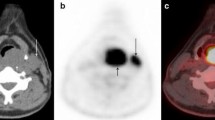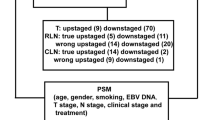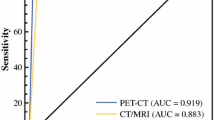Abstract
The objective of this study is to determine the size range where the recovery coefficient (RC) method of fluorodeoxyglucose (FDG) positron emission tomography–computed tomography (PET–CT) is helpful in detecting lateral retropharyngeal lymph (LRPL) nodal metastases of nasopharyngeal carcinoma (NPC) patients previously treated with radiation therapy. A total of 142 LRPL nodes assessed by magnetic resonance imaging (MRI) in 71 NPC patients were chosen for investigation. LRPL nodes with central necrosis, extracapsular invasion, or asymmetric grouping or those ascertained on follow-up MRI scans were considered positive for metastases. The criterion for positive diagnosis of nodal metastasis on FDG PET–CT scans was defined as maximal standard uptake value (SUVmax) ≥ 2.5. Nodes not separated from main tumors were excluded. An established RC method, the sphere-to-background ratio, was employed. Nodes were further categorized into three groups of minimal axial diameters: below 6, 6–7 mm, and above 7 mm. A total of 88 nodes were examined by FDG PET. Thirty-five nodes were positive and 53 nodes were negative. The RC method significantly improved sensitivity (from 20 to 100 %) and accuracy (from 14 to 71 %) for nodes sized 6–7 mm. In LRPL nodes above 7 mm, the RC method also provided slight improvement, with sensitivity and accuracy both increasing from 92 to 96 %. However, the nodal sizes below 6 mm were too small for valid comparisons. In conclusion, partial volume correction in FDG PET–CT enhances the accuracy of detecting nodes in the equivocal size range of 6–7 mm for LRPL nodal metastases of NPC.




Similar content being viewed by others
References
Yu, E., O’Sullivan, B., Kim, J., Siu, L., & Bartlett, E. (2010). Magnetic resonance imaging of nasopharyngeal carcinoma. Expert Review of Anticancer Therapy, 10, 365–375.
Zhang, G. Y., Liu, L. Z., Wei, W. H., Deng, Y. M., Li, Y. Z., & Liu, X. W. (2010). Radiologic criteria of retropharyngeal lymph node metastasis in nasopharyngeal carcinoma treated with radiation therapy. Radiology, 255, 605–612.
Sharma, M., Bartlett, E., & Yu, E. (2010). Metastatic retropharyngeal lymph nodes in nasopharyngeal carcinoma: Imaging criteria. Expert Review of Anticancer Therapy, 10, 1703–1706.
Ng, S. H., Chang, J. T., Chan, S. C., Ko, S. F., Wang, H. M., & Liao, C. T. (2004). Nodal metastases of nasopharyngeal carcinoma: patterns of disease on MRI and FDG PET. European Journal of Nuclear Medicine and Molecular Imaging, 31, 1073–1080.
Hoffman, E. J., Huang, S. C., & Phelps, M. E. (1979). Quantitation in positron emission computed tomography: 1. Effect of object size. Journal of Computer Assisted Tomography, 3, 299–308.
Rousset, O. G., Ma, Y., & Evans, A. C. (1998). Correction for partial volume effects in PET: Principle and validation. Journal of Nuclear Medicine, 39, 904–911.
Sakaguchi, Y., Mizoguchi, N., Mitsumoto, T., Mitsumoto, K., Himuro, K., & Ohya, N. (2010). A simple table lookup method for PET-CT partial volume correction using a point-spread function in diagnosing lymph node metastasis. Annals of Nuclear Medicine, 24, 585–591.
Greene, F. L., Page, D. L., Fleming, I. D., Fritz, A. G., Balch, C. M., Haller, D. G., & Morrow, M. (2002). AJCC cancer staging handbook sixth edition TNM classification of malignant tumors. New York: Springer.
Miller, A. B., Hoogstraten, B., Staquet, M., & Winkler, A. (1981). Reporting results of cancer treatment. Cancer, 47, 207–214.
Wang, Y. W., Wu, C. S., Cheng, K. S., Chang, Y. K., Lee, S. W., Chang, C. H., et al. (2011). Defining partial and complete resolution and correcting label misplacement in figures of retropharyngeal node metastasis in nasopharyngeal cancer. Radiology, 259, 612.
Srinivas, S. M., Dhurairaj, T., Basu, S., Bural, G., Surti, S., & Alavi, A. (2009). A recovery coefficient method for partial volume correction of PET images. Annals of Nuclear Medicine, 23, 341–348.
Chen, C. H., Muzic, R. F, Jr, Nelson, A. D., & Adler, L. P. (1999). Simultaneous recovery of size and radioactivity concentration of small spheroids with PET data. Journal of Nuclear Medicine, 40, 118–130.
Edge, S. B., Byrd, D. R., Compton, C. C., Fritz, A. G., Greene, F. L., & Trotti, A. (2010). AJCC cancer staging handbook from the AJCC cancer staging manual (7th ed.). New York: Springer.
Geworski, L., Knoop, B. O., de Cabrejas, M. L., Knapp, W. H., & Munz, D. L. (2000). Recovery correction for quantitation in emission tomography: A feasibility study. European Journal of Nuclear Medicine, 27, 161–169.
Vriens, D., Visser, E. P., de Geus-Oei, L. F., & Oyen, W. J. (2010). Methodological considerations in quantification of oncological FDG PET studies. European Journal of Nuclear Medicine and Molecular Imaging, 37, 1408–1425.
Soret, M., Bacharach, S. L., & Buvat, I. (2007). Partial-volume effect in PET tumor imaging. Journal of Nuclear Medicine, 48, 932–945.
Liu, W. S., Wu, M. F., Tseng, H. C., Liu, J. T., Weng, J. H., & Li, Y. C. (2012). The role of pretreatment FDG-PET in nasopharyngeal carcinoma treated with intensity-modulated radiotherapy. International Journal of Radiation Oncology Biology Physics, 82, 561–566.
Avril, N., Bense, S., Ziegler, S. I., Dose, J., Weber, W., Laubenbacher, C., et al. (1997). Breast imaging with fluorine-18-FDG PET: Quantitative image analysis. Journal of Nuclear Medicine, 38, 1186–1191.
Acknowledgments
This study was supported by project Grant CLFHR10017 from Chi Mei Medical Center, Liouying (Yu-Wen Wang). The authors deeply appreciate the manuscript preparation assistance from Shan-Tair Wang, PhD and Michael Chang (macst34@gmail.com).
Conflict of interest
The authors affirm no conflict of interest or use of copyrighted information in this research. We have safeguarded personal patient privacy. We have disclosed all financial relationships for the manuscript and work.
Funding
Supported by project Grant CLFHR10017 from Chi Mei Medical Center, Liouying (Yu-Wen Wang).
Author information
Authors and Affiliations
Corresponding author
Rights and permissions
About this article
Cite this article
Wang, YW., Wu, CS., Chang, CH. et al. Partial Volume Correction for Equivocal Retropharyngeal Nodal Metastases of Nasopharyngeal Carcinoma with Fluorodeoxyglucose Positron Emission Tomography–Computed Tomography. J. Med. Biol. Eng. 35, 218–225 (2015). https://doi.org/10.1007/s40846-015-0023-x
Received:
Accepted:
Published:
Issue Date:
DOI: https://doi.org/10.1007/s40846-015-0023-x




